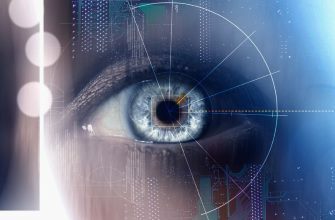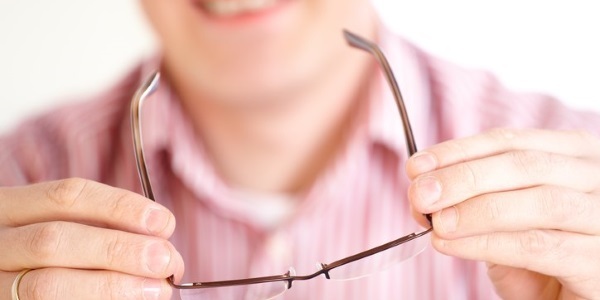
Eye problems caused by heavy eye strain are a real scourge of modern people.
Prolonged work with a computer, watching TV, huge volumes of books read can not help but affect its sharpness and clarity. Of course, overexertion is not the only cause of visual impairment, but one of the most common.
And in the early stages of the change can proceed almost unnoticeably: a person simply does not pay attention to what he sees a little worse than before, until the problem becomes really serious and does not force one to turn to a specialist.
When checking the eyes in the office of the ophthalmologist, you can see how the doctor writes the numbers in the medical book: 1.0, 0.75, -0.5.Unit is normal vision.
Deviations from this figure with the plus sign indicate hyperopia, or hypermetropia, with a minus sign indicate myopia, also called myopia. In the case of astigmatism, these values are different for the left and right eyes.
- 1. Vision minus 0.5( -0.5)
- 2. Vision plus 0.5( +0.5)
- 3. Conclusion
- 4. Optional
Vision minus 0.5( -0.5)

The standard table for determining visual acuity has ten rows of gradually decreasing letters.
The upper ones are the largest ones, the lower ones are quite small. A person with 100% vision can easily distinguish all the letters of the table. The worse it is, the less lines you can read.
To measure the optical power of the eyes, use the unit of measurement - diopters .The value of -0,5 indicates the presence of myopia.
How does myopia affect vision?
The very name of the disease says that the vision remains good enough only near. The far-away objects spread out and become visible indistinctly, blurred, because the eyeball acquires an elongated shape and is unable to focus on them: the light rays refracted by the lens collect in one point not on the surface of the retina, as it should be normal, but in front of it.
To view distant objects suffering from myopia, the patient blinks, reads the book close to his eyes, pushes the computer monitor to the edge of the table, so that the image on the screen is as close as possible.
With vision -0.5 all these symptoms are not as pronounced as in severe forms of myopia. The inconvenience arises only because of certain activities that require concentration and high visual acuity - car driving, beading, embroidery, outdoor games: tennis, badminton, golf.
What causes the disease?
The loss of the shape of the eyeball, the violation of the refraction of the lens by light rays and the resulting myopia arises from a variety of different causes. These include:
- Overexertion of the eyes. The reason for this is a failure to comply with the rules of working with a computer or too long stay behind the monitor, reading in low light conditions. This is the most common cause of myopia, causing more than half of its cases, and the most favorable in terms of predictions.
- Chronic infections, rickets, deficiency of vitamins and nutrients and other factors that lead to general weakness of the body and thinning of the sclera.
- Hereditary predisposition. Very often in myopia-affected parents, children suffer from the same problem from an early age. Therefore, in the presence of myopia in the mother or father should be very careful about the state of the child's eyes and do not neglect regular visits to the ophthalmologist.
- Connective tissue dysplasia. This systemic pathology is accompanied not only by myopia, but also by a whole complex of cardiovascular and musculoskeletal disorders.
- Congenital malformations. With intrauterine disorders of the formation of the eyeball, it can acquire an elongated shape and lose the ability to accommodate.

There is also false myopia, often developing in diabetes mellitus and the use of certain medications, such as antibiotics from the sulfonamide group. With her, the shape of the eyeball remains within normal limits, and vision returns to its former value when drugs are withdrawn or the blood sugar level is normalized.
It is worth remembering that even if there is a propensity for myopia, it does not necessarily make itself felt, and the disease can be prevented by carefully treating the vision.
Do I need glasses or lenses?
Many people think that wearing glasses with myopia and hyperopia leads to the fact that the eye begins to "lazy", and the deterioration in vision progresses faster. In fact, this is not so. Moreover, with severe myopia, their wearing is necessary.
But with a vision of -0.5, it is possible to dispense with lenses and glasses most of the time and wear them only to perform the necessary high visual acuity of activities.
Can I fully restore my eyesight or improve it?
In some cases this is possible. In the case of mild myopia( up to -2 ) due to overexertion of the eyes, good results are achieved by gymnastics aimed at training the muscles of the eyeball. From time to time, you should break away from your usual activities and perform the following exercises:
- With a look of wide-open eyes, outline the figure-eight first to the right, then to the left. Repeat 5-10 times in a row.
- Focus the vision first on a closely located object, then switch to a farther object. Do this 5-10 times.
- Pull out your hand with an object( a pencil is good) and, following it from side to side, follow his gaze, keeping his head still.
- Putting your feet to the width of your shoulders, and placing your arms on your belt, slowly turn your head to the left and to the right, focusing your eyes on the objects located around them. Make 20 rotations in each direction.
In severe cases, the exercises are unlikely to be effective, and the patient will be helped only by surgical intervention, but with a vision of -0.5 they are sometimes enough to return to the coveted unit.
Vision plus 0.5( +0.5)
If the specialist on the basis of the results of a visual test has given this figure, this indicates hyperopia. Known also as hypermetropia, it occurs in young people much less often myopia. Hyperopia mainly affects people older than 45 years.
Hyperopia is also characteristic of preschool children - in this case, it passes without a trace with the formation of the visual apparatus.
How does hyperopia affect vision?
This disease has a talking name: it's easy to guess that when a person starts hypermetropia, it's bad to see near, while distant objects remain relatively clear.
When reading, the patient tries to keep the book out of sight, steps back a few steps from objects that are going to be scrutinized. Due to constant eye strain, constant focus on nearby objects often causes headaches and nausea.
With +0,5 acuity, the symptoms of hyperopia are not very pronounced, but they are already beginning to become visible to the patient himself, and begin to interfere with needlework, drawing and similar activities.
What causes the disease?
Compounding the eyeball or breaking the refraction of sunlight by the lens causes the rays of light to focus not on the surface of the retina, but behind it. The main reason for the occurrence of hyperopia is the age-related changes. It occurs in almost all people over 65 years of age.
In children, hypermetropia is observed from birth to 5-6 years due to underdeveloped vision. Usually it passes with age, but with intrauterine developmental disorders, the eye can remain for life and lead to concomitant diseases such as strabismus and amblyopia.
Do I need glasses or lenses?
Many people with visual impairments are afraid to wear lenses and glasses because they are afraid of the progress of the disease. There is an opinion that without constant stress the eyes will begin to see even worse. However, this is a delusion.
If the farsightedness does not exceed +0.5 , without glasses it is possible to manage most of the time. They should be worn only at work, for which good vision is necessary.
Can I completely restore my eyesight or improve it?
Prognosis for hyperopia is usually worse than with myopia - the age-related changes in the eyeball are almost impossible to reverse. The only radical method is surgery for laser vision correction. However, gymnastics for the eyes will help slow the progress of the disease. To do this, perform the following exercises twice a day:
- Standing opposite the wall clock, you need to alternately focus on the digits 9 , 12 , 3 and 6 , making rotational movements of the eyes first clockwise and then against. It's better to start with 2-3 approaches, every day doing on 2-3 more.
- To make quick movements of the eyes to the left and to the right, and then up and down. The number of approaches is similar to the previous exercise.
- As well as with myopia, focus the vision first on a closely located object, and then - translate it to a more distant object. This should be done 5-10 times.
This will strengthen the muscles of the eyeball and improve blood circulation in it, reduce eye fatigue.
Conclusion
In conclusion, we can say the following:
- Any numbers with a minus sign indicate short-sightedness, and with a plus sign for farsightedness;
- As -0,5 , and +0,5 - not the worst indicators, in which the visual impairment is weak enough and does not cause big inconveniences;
- In the first case, the patient sees worse objects far away, in the second - objects closer to him;
- With a small plus and minus, you can do without glasses and wear them only in activities that require high visual acuity, but you should not abandon them completely;
- Nearsightedness most often arises because of loads on the organs of vision and hereditary predisposition, and hyperopia is predominantly an age-related problem.
This video might be interesting for you:
Additionally
Use these images to keep the eye muscles in tone and to avoid eyestrain distortions:
